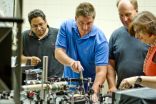Blacks in all socioeconomic groups have poorer outcomes after heart attack
American Heart Association Rapid Access Journal Report
2015-09-14
(Press-News.org) DALLAS, Sept. 14, 2015 -- Black patients and patients with low socioeconomic status have shorter life expectancies after a heart attack. However, the largest racial differences in life expectancy after a heart attack occur in patients with high socioeconomic status, according to research in the American Heart Association journal Circulation.
"Race and socioeconomic status are intimately related, with black individuals bearing a disproportionate burden of the poverty and health inequalities in the U.S.," said Emily Bucholz, M.D., MPH, Ph.D., lead author of the study and resident at Boston Children's Hospital. "Prior research has shown that blacks fare worse after cardiac events, yet little is known about how these factors interact to affect outcomes after heart attack."
Researchers, evaluating Medicare data based on zip code information on 132,201 white patients and 8,894 black patients in the U.S. found on average: white patients lived longer than black patients after a heart attack and patients with high socioeconomic status lived longer than those with low socioeconomic status:
Overall, white patients lived an average of 6.4 years after heart attack whereas black patients lived an average of 5.6 years.
Racial differences in life expectancy were largest in patients with high socioeconomic status and lowest in patients with low socioeconomic status. Among those living in high socioeconomic communities, life expectancy was 7.0 years in white patients and 6.3 years in black patients.
Among those living in low socioeconomic areas, life expectancy was 5.6 in white patients and 5.4 in black patients.
Much of the racial difference in life expectancy was explained by the higher rate of cardiovascular disease risk factors (diabetes, hypertension, smoking) and lower treatment rates in black patients
"The implication here is that black patients and poor patients are disadvantaged -- and higher socioeconomic status does not eliminate racial disparities," said Harlan Krumholz, M.D., M.S., study co-author and researcher at Yale University in New Haven, Connecticut. "We have work to do to understand why blacks are disadvantaged and immediately address it."
The study was based on data from the mid-1990s, but the findings still provide additional context on where to direct future heart health initiatives, said Bucholz.
"What was most surprising to us was that the greatest gap in life expectancy after a heart attack was between blacks and whites at the higher end of the socioeconomic status spectrum," Bucholz said. "We don't know why this is, but it indicates that blacks with greater resources remain vulnerable to poorer outcomes."
INFORMATION:
Co-authors are Shuangge Ma, Ph.D., and Sharon-Lise Normand, Ph.D.
The National Heart, Lung, and Blood Institute and the National Institute of General Medical Sciences funded the study. Author disclosures are on the manuscript.
Additional Resources:
Researcher photo, heart illustrations, and heart animations are available on the right column of this release link: http://newsroom.heart.org/news/blacks-in-all-socioeconomic-groups-have-poorer-outcomes-after-heart-attack?preview=0d326218d501c95c5a31168f43e6cc3f
African-Americans at lower socioeconomic levels have increased risk of heart disease, stroke
After Sept. 14, 2015, view the manuscript online.
AHA Heart Attack Website
Follow AHA/ASA news on Twitter @HeartNews.
For updates and new science from Circulation, follow @CircAHA.
Statements and conclusions of study authors published in American Heart Association scientific journals are solely those of the study authors and do not necessarily reflect the association's policy or position. The association makes no representation or guarantee as to their accuracy or reliability. The association receives funding primarily from individuals; foundations and corporations (including pharmaceutical, device manufacturers and other companies) also make donations and fund specific association programs and events. The association has strict policies to prevent these relationships from influencing the science content. Revenues from pharmaceutical and device corporations are available at http://www.heart.org/corporatefunding.
ELSE PRESS RELEASES FROM THIS DATE:
2015-09-14
The processes of globalization should have contributed to reduced inequality in the world. In reality, however, the situation looks differently, with income inequality in the populations of developing economies growing. To correct this, the level of education of low-skilled workers must be increased, said Eric Maskin, Chief Research Fellow at the HSE International Laboratory of Decision Choice and Analysis and Nobel Laureate in Economics for 2007.
In the last 20 years, the world has experienced unprecedented growth in global markets. Trading borders between countries ...
2015-09-14
TV screens that roll up. Roofing tiles that double as solar panels. Sun-powered cell phone chargers woven into the fabric of backpacks. A new generation of organic semiconductors may allow these kinds of flexible electronics to be manufactured at low cost, says University of Vermont physicist and materials scientist Madalina Furis.
But the basic science of how to get electrons to move quickly and easily in these organic materials remains murky.
To help, Furis and a team of UVM materials scientists have invented a new way to create what they are calling "an electron ...
2015-09-14
Free - or very inexpensive - online courses have become quite a trend in education. Massive Open Online Course (MOOC) providers currently offer thousands of courses and have enticed millions of students to enroll. The emphasis in MOOCs is often on lecture videos that students watch and learn from.
However, a study published in the Proceedings of the Second (2015) ACM Conference on Learning @ Scale shows that this central approach of MOOCs - having students watch to learn - is ineffective. Instead, the emphasis on interactive activities as advocated by Carnegie Mellon ...
2015-09-14
KINGSTON - New research out of Queen's University has found evidence of emotional load sharing between partners in a close relationship. The study, co-authored by PhD candidate Jessica Lougheed, found that a strong relationship with a loved one can help ease stress when placed in difficult situations.
"We wanted to test a new evolutionary theory in psychology called Social Baseline Theory which suggests that humans adapted to be close to other humans," says Ms. Lougheed. "The idea is that individuals function at a relative deficit when they are farther away from people ...
2015-09-14
This news release is available in Spanish.
The plants on the highest mountain in Ecuador have migrated more than 500 meters to higher altitudes during the last two centuries. This is determined in a new study, in which Aarhus University researchers compared Humboldt's data from 1802 with current conditions.
Although most of the world's species diversity is found in tropical areas, there are very few studies that have examined whether tropical mountain species are affected by climate change to the same extent as temperate species. A new study has now determined ...
2015-09-14
A recently identified molecule produced by skeletal muscle in response to exercise, has been shown to increase bone mass, according to a collaborative study between researchers at the Mount Sinai Bone Program, Icahn School of Medicine at Mount Sinai, the Department of Experimental and Clinical Medicine at University of Ancona in Italy, and the Department of Basic Medical Science, Neuroscience and Sense Organs at the University of Bari in Italy, and published online today in the Proceedings of the National Academy of Sciences (PNAS).
Although exercise is a well known ...
2015-09-14
People with congenital stationary night blindness, or CSNB, have normal vision during the day but find it difficult or impossible to distinguish objects in low light. This rare condition is present from birth and can seriously impact quality of life, especially in locations and conditions where artificial illumination is not available.
Working in collaboration with Japanese scientists, researchers at the University of Pennsylvania have for the first time found a form of CSNB in dogs. Their discovery and subsequent hunt for the genetic mutation responsible may one day ...
2015-09-14
A new study from the Gladstone Institutes shows for the first time that impairments in mitochondria--the brain's cellular power plants--can deplete cellular energy levels and cause neuronal dysfunction in a model of neurodegenerative disease.
A link between mitochondria, energy failure, and neurodegeneration has long been hypothesized. However, no previous studies were able to comprehensively investigate the connection because sufficiently sensitive tests, or assays, were not available to measure ATP (the energy unit of the cell that is generated by mitochondria) in individual ...
2015-09-14
WASHINGTON (Sept. 14, 2015) -- According to initial results of a multi-site landmark study, led by Dominic Raj, M.D., at the George Washington University (GW) site, cardiovascular disease morbidity is significantly reduced through intensive management of high blood pressure.
By targeting a blood pressure of 120 millimeters of mercury (mm Hg), lower than current guidelines, researchers found that adults 50 years and older also significantly reduced their rates of cardiovascular disease and cardiovascular events, such as heart attack and heart failure, as well as stroke, ...
2015-09-14
Humans are extremely choosy when it comes to mating, only settling down and having kids after a long screening process involving nervous flirtations, set-ups by friends, online matchmaking sites, awkward dates, humiliating rejections, hasty retreats and the occasional lucky strike. In the end, we "fall in love" and "live happily ever after." But evolution is an unforgiving force - isn't this choosiness rather a costly waste of time and energy when we should just be "going forth and multiplying?" What, if anything, is the evolutionary point of it all? A new study may have ...
LAST 30 PRESS RELEASES:
[Press-News.org] Blacks in all socioeconomic groups have poorer outcomes after heart attack
American Heart Association Rapid Access Journal Report


